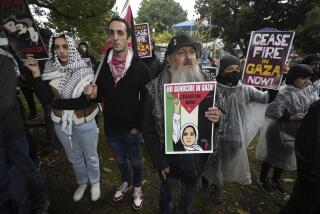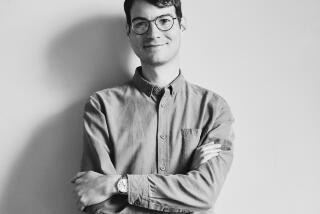50 Years Later, Horror of Babi Yar Is Recalled : Soviet Union: One woman tells how she survived as ceremony marks the massacre of Jews by Nazis.
KIEV, Soviet Union â Raisa G. Dashkevich stood Sunday at the edge of the ravine known as Babi Yar where she had stood exactly 50 years before when Nazi soldiers were executing tens of thousands of Jews.
âThe closer I get to the ravine, the stronger I feel,â the 75-year-old retired accountant said as tears streamed down her face. âThe whole tragedy goes before my eyes like a movie.â
She recalled that she clasped her 3-year-old son to her breast and accepted that their lives were over. Then she heard machine-gun fire. But before the bullets reached her, she fainted and fell about 100 feet into the pit. She awoke in a pile of thousands of bodies and, miraculously, crawled out alive.
Now, 50 years later, white-haired but still young at heart, Dashkevich was among thousands of people who flocked to Babi Yar to mark the tragedyâs anniversary.
A requiem played over a loudspeaker as they gathered around a new bronze menorah installed at the ravine to mark where the Nazis killed 33,741 Jews in two days, just nine days after they occupied Kiev during World War II.
The Nazis kept killing Jews--along with Gypsies, war criminals, Communists and others--at the ravine over the next two years, until the Soviet army regained control of Kiev. They stopped keeping count after the first several days, but estimates of the number of people killed at Babi Yar are as high as 200,000.
The mass executions at Babi Yar have long been regarded as one of the Nazisâ most barbaric acts of the Holocaust. And even two decades after the tragedy, the Soviet government had not marked the site, an omission denounced by Yevgeny Yevtushenko in his famous poem âBabi Yarâ:
âThe wild grasses rustle over Babi Yar. The trees look ominous, like judges. Here all things scream silently, and, baring my head, slowly I feel myself turning gray. And I myself am one massive, soundless scream above the thousand thousand buried here. I am each old man here shot dead. I am every child here shot dead. Nothing in me shall ever forget! The âInternationaleâ let it thunder when the last anti-Semite is buried forever.â
Then, in 1966, a bold Soviet-style statue was raised in honor of those who died at Babi Yar. But it is about half a mile from the actual site of the tragedy. Featuring muscular young sailors, it fails to recognize that Jews more than any other group perished here.
âThe monument is all wrong,â Dashkevich said as she attended a ceremony there earlier in the day. âIt shows people ready to fight. But we could not fight--we were like cattle on the way to slaughter.â
With most able-bodied men at the front, the Jews who abandoned their homes and walked, hobbled or were carried to their deaths on Sept. 29, 1941, were mainly children, women, elderly people and invalids.
âThere were so many Jews in Kiev at the time,â Dashkevich said, âthat from all the streets and alleys came streams of people who joined together to make a big river of people flowing toward Babi Yar.â
They had been ordered to gather at an intersection not far from the Jewish cemetery. Like most of the rest of the Jews in the city, Dashkevich thought they would be put on trains and taken to a ghetto.
Together with 15 relatives--including her son, parents and three sisters--she made the 10-mile walk across the city to the wooded area surrounding Babi Yar.
âAs soon as we got close, we could hear the sound of machine guns,â Dashkevich recalled, choking back emotion. âBy that time, we knew there was no turning back. We knew we were going to our deaths.â
At the cemetery, German soldiers and Ukrainian police forced their victims to strip and beat them with nightsticks.
âI remember how people screamed, went out of their minds and pulled out their hair,â she said. âThere were cries of children, moans of old people and screams of mothers as their babies were snatched from their arms and flung into the ravine alive.â
At twilight, it was Dashkevichâs turn. She could not see the gunmen as she stood at the edge of the cliff. About 100 feet below her, she saw countless corpses.
Her next memory is regaining consciousness, shivering from the cold and losing consciousness again. She again awoke to the sound of dogs barking.
âMy child was cold next to me. I knew he was dead. I felt enormous pressure from the corpses on top of me, and I started to dig my way out.â
Somehow she managed to climb out of the 100-foot ravine and make her way through the brush and nearby forest without being caught by the German soldiers.
âFear gives you remarkable strength. I was young and strong. I believe it was God who helped me do it. God saved me.â
Covered with dirt, blood and bruises and wearing only a slip, Dashkevich knocked on the door of a small hut not far from Babi Yar. When a peasant woman appeared, Dashkevich fainted again. The woman bathed her, fed her and nursed her bruised body for three days.
âIt was very dangerous for her,â Dashkevich said. âIt was not far from the ravine, and if the Germans had found me, they would have shot her whole family.â
On the third day, dressed and fed, the woman sent her out, for fear of being discovered. Dashkevich never learned her name.
âI had lived in Kiev my whole life, but all of a sudden, the city was so strange and so hostile,â Dashkevich said. After being turned away by three of her closest friends, she took refuge at the home of a church elder, Ivan A. Bondarenko, who had hidden Jews from earlier pogroms in Kiev. He arranged false documents certifying her as a Ukrainian and a Christian, and he sheltered her until after the war.
When Soviet officials and the Ukrainian people discriminated against Jews who returned to Kiev after the war, Dashkevich decided to maintain her false identity.
âYou wouldnât believe the horrible things I heard about us, because no one knew I was a Jew myself,â she recalled with a shudder.
Each year on Sept. 29 she quietly slipped away to Babi Yar, with hopes of dropping flowers into the ravine where almost all her relatives had died. Police almost always prevented her.
Dashkevich concealed the fact that she was Jewish and kept her experiences secret until a couple of years ago. She kept the story from her second husband, who died in 1976, and from the third husband she married eight years ago--even though he is also Jewish.
Now she wears a large silver Star of David around her neck. She finally mustered the courage to tell her story at a Jewish cultural center that opened a few years ago in Kiev.
âWhen I went to that society for the first time and people spoke about themselves, I could not speak about myself. I just cried. For a half year, I cried constantly. It was all stored deep inside of my memory. Then it came gushing out. Only after all these years did I feel that it was safe to remember and give a testimony about my parents, my dead sisters and brothers, about everything that I had witnessed.â
It was then that she met Alexander A. Shlayen, a film director and chairman of the Babi Yar center, who had been working for many years to have a proper monument for the Jews who died there. On Sunday, Shlayenâs dream finally came true.
âThank God that we finally achieved this,â Shlayen said as he stood near the menorah. âIt has come at the price of 20 years of my life. I have been fired from my job, arrested, my house has been searched and in many other ways I have suffered so that I would see this day.â
During a simple ceremony at the 10-foot-high menorah, which stands just yards away from one opening of the ravine, Shlayen addressed the crowd: âI pray to God that what happened at Babi Yar will never be repeated and that each of us will always be able to say with pride: âI am a Jew.â â
More to Read
Sign up for Essential California
The most important California stories and recommendations in your inbox every morning.
You may occasionally receive promotional content from the Los Angeles Times.










